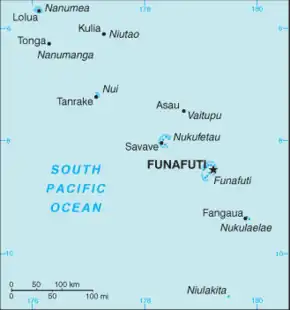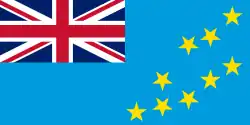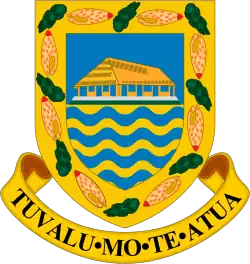Outline of Tuvalu
The following outline is provided as an overview of and topical guide to Tuvalu:


Tuvalu (formerly known as the Ellice Islands) – sovereign Polynesian island nation located in the South Pacific Ocean midway between Hawaiʻi and Australia.[1] Its nearest neighbours are Kiribati, Samoa and Fiji. Comprising three reef islands and six true atolls with a gross land area of just 26 square kilometers (10 sq mi) it is the third-least populated independent country in the world, with only Vatican City and Nauru having fewer inhabitants. It is also the second-smallest member by population of the United Nations. In terms of physical land size, Tuvalu is the fourth smallest country in the world, larger only than the Vatican City—0.44 km2; Monaco—1.95 km2 and Nauru—21 km2. Tuvalu's Exclusive Economic Zone (EEZ) covers an oceanic area of approximately 900,000 km2.[2]
The first inhabitants of Tuvalu were Polynesians. Therefore, the origins of the people of Tuvalu are addressed in the theories regarding the spread of humans out of Southeast Asia, from Taiwan, via Melanesia and across the Pacific islands to create Polynesia.
Tuvalu was first sighted by Europeans on 16 January 1568 during the voyage of Álvaro de Mendaña de Neira from Spain who is understood to have sighted the island of Nui. Mendaña made contact with the islanders but was unable to land.[3] During Mendaña's second voyage across the Pacific he passed Niulakita on 29 August 1595.[3][4] Captain John Byron passed through the islands of Tuvalu in 1764 during his circumnavigation of the globe as captain of HMS Dolphin.[5]
Keith S. Chambers and Doug Munro (1980) identify Niutao as the island that Francisco Mourelle de la Rúa sailed past on 5 May 1781, thus solving what Europeans had called The Mystery of Gran Cocal.[4][6] Mourelle's map and journal named the island El Gran Cocal ('The Great Coconut Plantation'); however, the latitude and longitude was uncertain.[6] Longitude could only be reckoned crudely as accurate chronometers were available until the late 18th century. Visits to the islands became more frequent in the 19th century.
The islands came under Britain's sphere of influence in the late 19th century. The Ellice Islands were administered by Britain as a protectorate as part of the British Western Pacific Territories from 1892 to 1916 and as part of the Gilbert and Ellice Islands Colony from 1916 to 1974. In 1974 the Ellice Islanders voted for separate British dependency status for Tuvalu, separating from the Gilbert Islands which became Kiribati upon independence. Tuvalu became fully independent within The Commonwealth in 1978. On 17 September 2000 Tuvalu became the 189th member of the United Nations.
General reference
- Pronunciation:
- Common English country name: Tuvalu
- Official English country name: Tuvalu
- Common endonym(s):
- Official endonym(s):
- Adjectival(s): Tuvaluan
- Demonym(s): Tuvaluan
- Etymology: From first settlement, eight of the nine islands of Tuvalu were inhabited; thus the name, Tuvalu, means "eight standing together" in Tuvaluan (compare to *walo meaning "eight" in Proto-Austronesian)..
- ISO country codes: TV, TUV, 798
- ISO region codes: See ISO 3166-2:TV
- Internet country code top-level domain: .tv
Geography of Tuvalu
Geography of Tuvalu: The islands of Tuvalu are spread out between the latitude of 5° to 10° south and longitude of 176° to 180°, west of the International Date Line.[7]
Geographic coordinates: 5°41′S 176°12′E to 10°45′S 179°51′E
- Tuvalu is...
- Location:
- Southern Hemisphere and Eastern Hemisphere
- Pacific Ocean
- Time zone: Tuvalu Time (UTC+12)
- Extreme points of Tuvalu
- High: unnamed location on Niulakita 4.5 m (15 ft)
- Low: South Pacific Ocean 0 m
- Land boundaries: none
- Coastline: South Pacific Ocean 24 km
- Population of Tuvalu: 10,837 (2012 Population & Housing Census Preliminary Analytical Report)[8] - 229th most populous country
- Area of Tuvalu: 26 km2
- Atlas of Tuvalu
Environment of Tuvalu
- Climate of Tuvalu
- Geology of Tuvalu
- Protected areas of Tuvalu
- Funafuti Conservation Area
- Biosphere reserves in Tuvalu
- Fauna of Tuvalu
- Flora of Tuvalu
Natural geographic features of Tuvalu
Tuvalu consists of three reef islands and six true atolls, whose highest point above the sea is five metres.[9]
- Islands of Tuvalu
- Coral reefs of Tuvalu
- Lakes of Tuvalu: landlocked lagoons in Nanumaga and Niutao[9]
- Rivers of Tuvalu: none[9]
- World Heritage Sites in Tuvalu: none
Regions of Tuvalu
Islands of Tuvalu Local government districts consisting of more than one islet:
Local government districts consisting of only one island:
Ecoregions of Tuvalu
Demography of Tuvalu
Government and politics of Tuvalu
- Form of government: parliamentary monarchy (Commonwealth realm)
- Capital of Tuvalu: Funafuti
- Elections in Tuvalu
- Political parties in Tuvalu: none
Branches of the government of Tuvalu
Executive branch of the government of Tuvalu
- Head of state: King of Tuvalu, Charles III, represented in Tuvalu by a Governor General appointed by the King upon the advice of the Prime Minister of Tuvalu
- Head of government: Prime Minister of Tuvalu
- Cabinet of Tuvalu
Legislative branch of the government of Tuvalu
Judicial branch of the government of Tuvalu
Foreign relations of Tuvalu
International organization membership
Tuvalu is a member of:[1]
Law and order in Tuvalu
Military of Tuvalu
Military of Tuvalu There is no military in Tuvalu. Its national police force, the Tuvalu Police Force headquartered in Funafuti, includes a maritime surveillance unit, customs, prisons and immigration.
Local government in Tuvalu
Culture of Tuvalu

- Architecture of Tuvalu
- Cuisine of Tuvalu
- Public holidays in Tuvalu
- Festivals in Tuvalu
- Tuvaluan language
- Tuvaluan mythology
- National symbols of Tuvalu
- People of Tuvalu
- Records of Tuvalu: Tuvalu National Library and Archives
- Religion in Tuvalu
- Christianity in Tuvalu: Church of Tuvalu
- Islam in Tuvalu
- World Heritage Sites in Tuvalu: None
Art in Tuvalu
Economy and infrastructure of Tuvalu
- Economic rank, by nominal GDP (2007): 190th (one hundred and ninetieth)
- Agriculture in Tuvalu
- Financial institutions in Tuvalu
- Communications
- Public sector enterprises of Tuvalu
- Private sector enterprises of Tuvalu
- Currency of Tuvalu: Tuvaluan dollar/Australian dollar
- Energy in Tuvalu
- Tourism in Tuvalu
- Transport in Tuvalu
Education in Tuvalu
Infrastructure of Tuvalu
- Health care in Tuvalu
- Transportation in Tuvalu
- Water supply and sanitation in Tuvalu
Filmography
Documentary films about Tuvalu:
- Tu Toko Tasi (Stand by Yourself) (2000) Conrad Mill, a Secretariat of the Pacific Community (SPC) production.[10]
- Paradise Domain – Tuvalu (Director: Joost De Haas, Bullfrog Films/TVE 2001)[11] 25:52 minutes - YouTube video.
- Tuvalu island tales (A Tale of two Islands) (Director: Michel Lippitsch) 34 minutes - YouTube video.
- The Disappearing of Tuvalu: Trouble in Paradise (2004) by Christopher Horner and Gilliane Le Gallic.[12]
- Paradise Drowned: Tuvalu, the Disappearing Nation (2004) Written and produced by Wayne Tourell. Directed by Mike O'Connor, Savana Jones-Middleton and Wayne Tourell.[13]
- Going Under (2004) by Franny Armstrong, Spanner Films.[11]
- Before the Flood: Tuvalu (2005) by Paul Lindsay (Storyville/BBC Four).[11]
- Time and Tide (2005) by Julie Bayer and Josh Salzman, Wavecrest Films [14]
- Tuvalu: That Sinking Feeling (2005) by Elizabeth Pollock from PBS Rough Cut
- Atlantis Approaching (2006) by Elizabeth Pollock, Blue Marble Productions [15]
- King Tide | The Sinking of Tuvalu (2007) by Juriaan Booij.[16]
- Tuvalu (Director: Aaron Smith, ‘Hungry Beast’ program, ABC June 2011) 6:40 minutes - YouTube video
- Tuvalu: Renewable Energy in the Pacific Islands Series (2012) Global Environment Facility (GEF), United Nations Development Programme (UNDP) and Secretariat of the Pacific Regional Environment Programme (SPREP) 10 minutes – YouTube video.
- Mission Tuvalu (Missie Tuvalu) (2013) feature documentary directed by Jeroen van den Kroonenberg.[17]
- ThuleTuvalu (2014) by Matthias von Gunten, HesseGreutert Film/OdysseyFilm.[18]
Bibliography
Further reading
- Lonely Planet Guide: South Pacific & Micronesia, by various. ISBN 1786572184 ISBN 978-1786572189
- Bennetts, Peter and Tony Wheeler, Time & Tide: The Islands of Tuvalu, Lonely Planet (2001) ISBN 1864503424 ISBN 978-1864503425
- Chalkley, John, Vaitupu – An Account of Life on a Remote Polynesian Atoll, Matuku Publications (1999)ISBN 9780953487608 ISBN 0953487601
- Ells, Philip, Where the Hell is Tuvalu? Virgin Books (2008) ISBN 0753511304 ISBN 978-0753511305
- Watling, Dick, A Guide to the Birds of Fiji and Western Polynesia: Including American Samoa, Niue, Samoa, Tokelau, Tonga, Tuvalu and Wallis and Futuna, Environmental Consultants (Fiji) Ltd; 2nd edition (2003) ISBN 9829030040 ISBN 9789829030047
- Randy Thaman, Feagaiga Penivao, Faoliu Teakau, Semese Alefaio, Lamese Saamu, Moe Saitala, Mataio Tekinene and Mile Fonua (2017). "Report on the 2016 Funafuti Community-Based Ridge-To-Reef (R2R)" (PDF). Rapid Biodiversity Assessment of the Conservation Status of Biodiversity and Ecosystem Services (BES) In Tuvalu. Retrieved 25 May 2019.
{{cite web}}: CS1 maint: multiple names: authors list (link)
- Customs and Traditions
- Brady, Ivan, Kinship Reciprocity in the Ellice Islands, Journal of the Polynesian Society 81:3 (1972), 290–316
- Brady, Ivan, Land Tenure in the Ellice Islands, in Henry P. Lundsaarde (ed). Land Tenure in Oceania, Honolulu, University Press of Hawaii (1974) ISBN 0824803213 ISBN 9780824803216
- Chambers, Keith & Anne Chambers Unity of Heart: Culture and Change in a Polynesian Atoll Society (January 2001) Waveland Pr Inc. ISBN 1577661664 ISBN 978-1577661665
- Koch, Gerd, Die Materielle Kulture der Ellice-Inseln, Berlin: Museum fur Volkerkunde (1961); The English translation by Guy Slatter, was published as The Material Culture of Tuvalu, University of the South Pacific in Suva (1981) ASIN B0000EE805.
- History
- Hedley, Charles (1896). "General account of the Atoll of Funafuti" (PDF). Australian Museum Memoir. 3 (2): 1–72. doi:10.3853/j.0067-1967.3.1896.487.
- Tuvalu: A History (1983) Isala, Tito and Larcy, Hugh (eds.), Institute of Pacific Studies, University of the South Pacific and Government of Tuvalu
- Suamalie N.T. Iosefa, Doug Munro, Niko Besnier, Tala O Niuoku, Te: the German Plantation on Nukulaelae Atoll 1865–1890 (1991) Published by the Institute of Pacific Studies. ISBN 9820200733
- Pulekai A. Sogivalu, Brief History of Niutao, A, (1992) Published by the Institute of Pacific Studies. ISBN 982020058X
- Macdonald, Barrie, Cinderellas of the Empire: towards a history of Kiribati and Tuvalu, Institute of Pacific Studies, University of the South Pacific, Suva, Fiji, (2001). ISBN 982-02-0335-X (Australian National University Press, first published 1982)
- Language
- Vaiaso ote Gana, Tuvalu Language Week Education Resource 2016 (New Zealand Ministry for Pacific Peoples)
- Besnier, Niko, Literacy, Emotion and Authority: Reading and Writing on a Polynesian Atoll, Cambridge University Press (1995) ISBN 0521485398 ISBN 978-0521485395
- Besnier, Niko, Tuvaluan: A Polynesian Language of the Central Pacific. (Descriptive Grammars) (2000) Routledge ISBN 0415024560 ISBN 978-0415024563
- Jackson, Geoff W. & Jenny Jackson, Introduction to Tuvaluan, An (1999) ISBN 9829027023 ISBN 978-9829027023.
- Jackson, Geoff W., Te Tikisionale O Te Gana Tuvalu, A Tuvaluan-English Dictionary (1994) Suva, Fiji, Oceania Printers. ASIN: B0006F7FNY.
- Kennedy, Donald Gilbert, Te ngangana a te Tuvalu – Handbook on the language of the Ellice Islands (1946) Websdale, Shoosmith, Sydney N.S.W.
- Music and Dance
- Christensen, Dieter, Old Musical Styles in the Ellice Islands, Western Polynesia, Ethnomusicology, 8:1 (1964), 34–40
- Christensen, Dieter and Gerd Koch, Die Musik der Ellice-Inseln, Berlin: Museum fur Volkerkunde (1964)
- Koch, Gerd, Songs of Tuvalu (translated by Guy Slatter), Institute of Pacific Studies, University of the South Pacific (2000) ISBN 9820203147 ISBN 978-9820203143
See also
References
- "Tuvalu". The World Factbook. United States Central Intelligence Agency. July 2, 2009. Retrieved July 23, 2009.
- Dr A J Tilling & Ms E Fihaki (17 November 2009). Tuvalu National Biodiversity Strategy and Action Plan (PDF). Fourth National Report to the Convention on Biological Diversity. p. 7.
- Maude, H.E. (1959). "Spanish Discoveries in the Central Pacific: A Study in Identification". 68 (4) The Journal of the Polynesian Society. pp. 284–326.
- Keith S. Chambers & Doug Munro (1980). The Mystery of Gran Cocal: European Discovery and Mis-Discovery in Tuvalu. 89(2) The Journal of the Polynesian Society. pp. 167–198.
- "Circumnavigation: Notable global maritime circumnavigations". Solarnavigator.net. Retrieved 2009-07-20.
- Laumua Kofe (1983). Tuvalu: A History, Palagi and Pastors, Ch. 15. Institute of Pacific Studies, University of the South Pacific and Government of Tuvalu.
- "Maps of Tuvalu". Retrieved 15 January 2021.
- "Tuvalu: Millennium Development Goal Acceleration Framework – Improving Quality of Education" (PDF). Ministry of Education and Sports, and Ministry of Finance and Economic Development from the Government of Tuvalu; and the United Nations System in the Pacific Islands. April 2013. Retrieved 13 October 2013.
- "Tuvalu", CIA World Factbook
- Phelan, Erin (15 May 2000). "Tuvalu In World TV Festival". Pacific Islands Report. Retrieved 30 September 2017.
- Mason, Moya K. (2017). "Tuvalu: Flooding, Global Warming, and Media Coverage". Moya K. Mason. Retrieved 30 September 2017.
- "DER Documentary: The Disappearing of Tuvalu: Trouble in Paradise". DER Documentary. 2004. Retrieved 30 September 2017.
- "Documentary: Paradise Drowned". NZ Geographic. 2004. Retrieved 30 September 2017.
- "Time and Tide". Wavecrest Films. 2005. Retrieved 30 September 2017.
- "Atlantis Approaching: The Movie". Blue Marble Productions. 2006. Retrieved 30 September 2017.
- "King Tide - The Sinking of Tuvalu". Juriaan Booij. 2007. Retrieved 30 September 2017.
- "Missie Tuvalu / Mission Tuvalu documentary". Omroep Brabant. 2013. Retrieved 30 September 2017.
- "ThuleTuvalu". HesseGreutert Film/OdysseyFilm. 2014. Retrieved 30 September 2017.
External links
External links
- Timeless Tuvalu - The Official Travel Website of Tuvalu
- Tuvalu at Curlie
- Small Is Beautiful A lobby group set up to help the island nation





